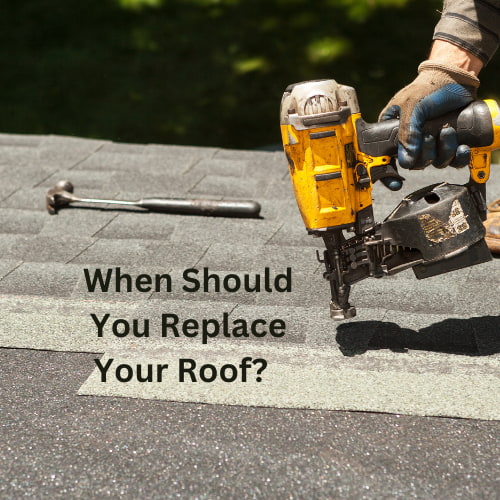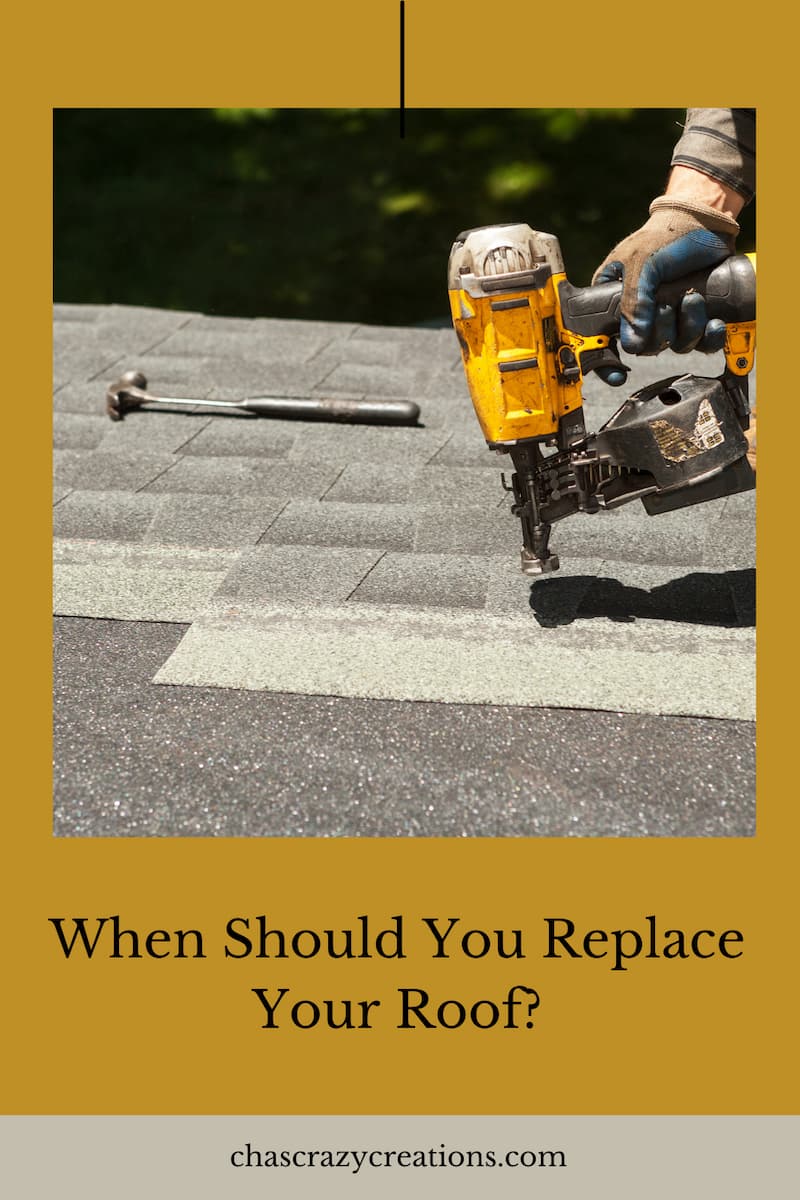When Should You Replace Your Roof
When should you replace your roof? Like many other homeowners, you probably understand the value and importance of a sturdy, reliable roof. They form your home’s front line of defense against weather, wildlife, and wear and tear. They are the epitome of comfort and safety.
This post may contain affiliate links, I earn from qualifying purchases at no extra cost to you. Click here for my disclosure policy
But how can you tell whether your roof is still fit for duty or not?
While regular repairs are inevitable during your roof‘s lifetime, there comes a time when your home is better off with an overhaul roof replacement.
Starting with a quick peek into roof life expectancies, let’s look at seven tell-tale indications that may suggest it’s time to replace your roof.

When Should You Replace Your Roof
How Long Can You Expect Your Roof to Stand Strong?
We all know that a well-maintained roof goes a long way in elevating your home’s curb appeal and resale value. But how long can it continue doing so from the day it was installed?
One simple rule of thumb used by experts is that a typical roof will last 20 to 25 years, but it may vary depending on various factors. These can include the quality of materials used, the skill and precision of installation, and the exposure to harsh weather conditions. It’s also
More durable types like metal or clay roofs can even stretch their lifespan up to 50 or even 100 years. Understanding your roof’s expected longevity is the first step toward making an informed decision about its replacement.
Choosing a Roof Replacement Company
When your roof has reached this crucial tipping point, picking the right company to entrust with its replacement is as vital as choosing the best fitting materials. Let’s offer a few tips to guide you through this phase.
To start with, it’s imperative to go local. By opting for a neighboring contractor, you tap into their understanding of your area’s peculiar regulations and weather patterns, securing impeccable, tailored service.
So if you’re hunting for roofers in New Orleans, going with a trusted local establishment ensures your new roof is ready to stand firm against the deep Southern downpours and scorching summers.
It’s also important that you do your homework – inquire with friends, check out online reviews, or ask neighbors who’ve had recent roofing jobs. Go for those highly recommended for peace of mind.
Finally, clarity is key in contracts & warranties on materials and craftsmanship alike. After all, solid paperwork can protect you from unnecessary future drama.
Shop any of these stores and I receive a small commission at no cost to you.
 Echo Dot (4th Gen, 2020 rel...Shop on Amazon
Echo Dot (4th Gen, 2020 rel...Shop on Amazon Apple AirTagShop on Amazon
Apple AirTagShop on Amazon Amazon Fire TV Stick, sharp...Shop on Amazon
Amazon Fire TV Stick, sharp...Shop on Amazon
Ways to Tell It’s Time to Replace Your Roof
1. The Deception of Shingle Curling: Is It Time for a Rehaul?
One of the most common tell-tale signs that your roof needs an overhaul is curling shingles. This can occur in two ways: cupping, where the shingle’s edges start to turn upward; and clawing, when the edges remain flat but the middle begins to come up.
Both situations indicate weathering and old age, suggesting that you might need a new roof in the next couple of years. Upon spotting this trademark sign of a worn-out rooftop, it is best to get an expert roofer involved to assess the extent of damage and possibly begin discussing replacement options.
2. Inspecting Interior Walls: Cracks, Stains, and Leakages
Beyond external indicators, interior walls can also provide clues about your roof’s condition. Watch out for dark spots or trails and places where outdoor light shines through. If you spot these signs, it’s probably time to contact a skilled roofer. They may suggest repair if the damage is localized or replacement if it’s widespread.
3. ‘Missing in Action’: Dealing with Disappearing Tiles or Shingles
Missing tiles or shingles compromise your roof’s primary function – shielding against adverse conditions. Gaps leave your home exposed to elements like rain and snow. So if you notice bald patches on your roof, consider calling in an expert for an evaluation – replacement could be on the cards.
4. Age Isn’t Just a Number: Estimating Your Roof’s Lifespan
How old is your roof exactly? While durability varies, the majority of roofs are only built to last 20 to 25 years. Factors such as ventilation quality and whether the new roof was installed over an old one could potentially shorten this lifespan. If your roof falls within (or beyond) this age range, it might be time for an upgrade.
5. Beware the Green Invasion: Moss and Algae on Your Rooftop
While a green roof definitely is charming, that’s not exactly true if it’s made of moss and algae. This could spell danger! They indicate moisture retention – a surefire step to deterioration.
Moreover, moss growth can directly damage shingles, especially in rainy climates. If you’re regularly scraping off these unwelcome guests or notice they return quickly after cleaning, it’s time to seek professional advice.
6. ‘Raining’ in Your Attic? Weather Damage as an Indicator
If your home seemed to fare well during that last big storm, don’t forget about your attic. Severe weather can often leave water stains on the ceiling beneath the attic or make it damp. If these signs become recurrent even after regular maintenance and repairs on roofing and ventilations, a roof replacement might be necessary.
After all, a robust roof means a dry and secure living space inside. Moisture in the attic is also a known culprit for causing mold and mildew growth, which could lead to property damage and health problems for dwellers if left unattended.
7. ‘Shedding’ Roofs: Accumulation of Shingle Granules in Gutters
An excess of granules finding their way into the gutters is a clear sign your roof is shedding and reaching the end of its life cycle. If instead of water, debris that you can protect with gutter guards, your gutter spouts are raining shingle particles, don’t ignore it. That’s a call for an immediate roof inspection.

What to look for in a bad roof?
Identifying signs of a bad roof is crucial to ensure the safety and integrity of your home. Here’s what to look for when assessing a roof for potential issues:
- Visible Damage: Inspect the roof for visible signs of damage, such as cracked, curled, or missing shingles. Damaged shingles can expose your roof to water infiltration.
- Granule Loss: Check for excessive granules in gutters and downspouts. Granule loss can lead to shingle deterioration and reduced protection from the elements.
- Bald Spots: Look for areas where shingles appear worn or bald, indicating significant wear and tear.
- Moss, Algae, or Mold: Excessive growth of these organisms can degrade shingles and retain moisture, accelerating roof deterioration.
- Sagging or Uneven Areas: A sagging roof could signify structural problems, and uneven areas might indicate improper installation or water damage.
- Interior Leaks: Water stains, damp spots, or mold on ceilings and walls are signs of roof leaks and should be addressed promptly.
- Peeling or Damaged Flashing: Damaged or improperly sealed flashing around chimneys, vents, skylights, and roof valleys can cause leaks.
- Chimney and Vent Issues: Inspect seals and flashing around chimneys, vents, and other roof penetrations for signs of deterioration.
- Roof Valleys: Cracked or missing shingles in valleys, where water flows, can lead to water penetration.
- Roof Rot or Decay: Soft or spongy areas on your roof deck or trusses may indicate rot or decay, particularly in wood-based roofing materials.
- Gutter Problems: Look for granule buildup in gutters, as well as damage to gutters and downspouts that could impact proper drainage.
- Peeling Paint or Stains on Exterior Walls: Stains or peeling paint on your home’s exterior walls, particularly around the roofline, can indicate water damage.
- Energy Inefficiency: Sudden spikes in energy bills may result from poor roof insulation and ventilation.
- Visible Sunlight in Attic: If you can see light coming through your roof boards from inside the attic, it suggests potential issues with your roof.
- Multiple Layers of Shingles: Having multiple layers of shingles might violate building codes and could be an indicator of underlying problems.
- Previous Repairs: Frequent or extensive past repairs could be a sign of an aging roof that may need replacement.
- Aging: Roofs have a limited lifespan. If your roof is nearing the manufacturer’s recommended lifespan, it’s more prone to issues.
- Neighborhood Trends: If many homes in your neighborhood are experiencing roof issues or replacements, it might be time to assess your roof as well.
- Weather Damage: Severe weather events, like storms, hail, or heavy snow, can cause immediate damage to your roof.
- Professional Inspection: When in doubt, hire a professional roofing contractor to perform a thorough inspection and provide expert advice.
Regular maintenance and addressing issues promptly can help prevent a bad roof from worsening and protect your home’s structural integrity.
Related Posts
- 3 Important Mobile Home Repairs You Should Never Ignore
- 3 Important General Home Repair and Maintenance Tasks
- House Repairs To Deal With Right Away
- Gutter Guards: Protecting Your Gutters with Gutter Screens and Gutter Guard Mesh
Recognizing these seven signs in your own home can save you a world of inconvenience down the line. Remember, waiting too long to replace a deteriorating roof may lead to more costly internal damage. So, stay vigilant and keep your home safe, dry, and comfortable by seeking timely professional help.








